Build deeper, with wider levees, authors say

Pond aquaculturists devote considerable time and effort to monitoring and managing their pond ecosystems. As the target species in most pond aquaculture occupies the water column, nearly all of these efforts are directed at understanding and improving conditions in the water. Most farmers, particularly those growing freshwater fish, generally are not concerned with conditions in the pond bottom soils.
Bottom soils are perceived primarily as construction material for pond levees. However, they are much more than simply an inert matrix that contains the pond water. Many of the chemical and biological processes responsible for proper functioning of the pond ecosystem occur in the pond bottom soil or across the soil-water interface.
Work conducted in 1977 by Val Mezainis at Auburn University and by Chad Berthelson in 1995 at Mississippi State University provided insights into the impact of bottom soils on dissolved-oxygen concentration in catfish ponds in the southern United States. Studies conducted by the authors over the last three years on the dissolved-oxygen budgets of channel catfish ponds in northwest Mississippi, USA showed that sediment accumulation has profound implications for the management and design of fish ponds.
Continuous pond use and erosion
Ponds used for production of market-size, 0.6-1.0 kg channel catfish are drained infrequently, because fish are produced in a continuous cycle of stocking, production, and harvest without draining the pond. On average, ponds are operated continuously for about eight years, with some ponds used for over 15 years without draining.
During this period of continuous use, wind-generated waves and aerator currents slowly erode the pond banks, and soil lost from the banks is deposited on the pond bottom. Ponds are usually drained only when erosion has reduced the top levee width to less than 2 m and vehicle passage down the levee becomes hazardous. After ponds are drained and dried, the material deposited on the pond bottom is pushed up onto the levees and compacted to restore the initial slope of the pond bank.
Sampling pond sediments
We sampled pond bottom sediments from 45 commercial channel catfish ponds that were in continuous fish production for periods ranging from 14 days to 21 years. Fifteen, 5-cm-diameter sediment core samples were obtained from each pond, and the depth of unconsolidated sediment was measured in each core.
Sediment depth
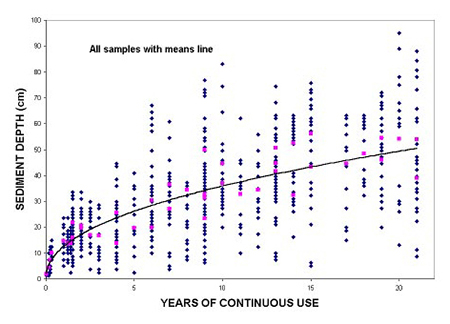
Sediment depth increased rapidly to an average of 12.5 cm after one year of fish production (Fig. 1). The rate of sediment accumulation was greatest during the first several years of production, and declined thereafter (Fig. 2).
Erosion of pond levees in newly constructed ponds is especially high, because the banks lack adequate grass cover to stabilize the soil. Levees should be sown as soon as possible with seed of a grass species appropriate to the region that creates a dense, low-growing cover. The rapid initial sedimentation rate also reinforces the importance of proper soil compaction of pond levees during construction.
Sediment distribution
The distribution of sediment depth within ponds is very heterogeneous, as anyone who has waded in aquaculture ponds knows well. Depressions in deep sediments of less than 2 m in diameter were scattered in an apparently random pattern throughout the ponds. These depressions, which give the bottom of drained ponds a “moonscape” appearance, may represent the locations of fish aggregation.
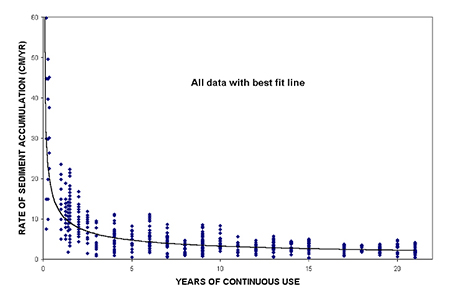
Sediment depth also varied from one end of the ponds to the other. On average, sediments in the shallow ends of ponds were 7 cm thinner than those in middle or deep areas. Water currents caused by frequent summertime aeration scoured the pond bottoms and moved sediments from shallow to deeper areas of ponds. In addition, sediments resuspended by shear forces at the pond bottom caused by wind-induced waves gradually move from shallow to deeper pond areas.
Based on the average rate of sediment accumulation documented in this study, a pond constructed with 1.5 m average water depth would contain only 1.1 m of water after 15 years of continuous use. Areas of maximum sediment accumulation would be covered by less than 70 cm of water. Actual pond water depth may be even less, because ponds with severely eroded levees are not filled to their original water level to prevent further erosion.
Implications
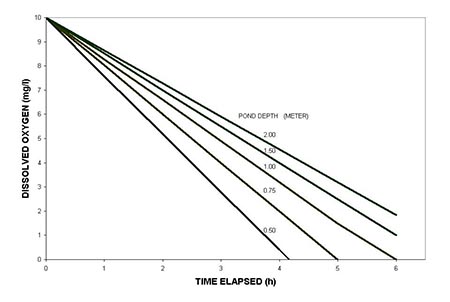
Aside from the need for periodic renovation of ponds to repair eroded levees and restore pond depth, the accumulation of sediment in ponds has two important implications for catfish farming. The most obvious consequence – and one familiar to all fish farmers – is the impact of sediments on the ease and effectiveness of seining at fish harvest.
Effect on harvesting
Seines for channel catfish are equipped with “gathered mesh” mudlines that help the weighted bottom line of the seine slide over, rather than dig into, the soft pond bottom. Bottom sediments in older ponds can be so deep that mudlines are ineffective, making it necessary to repeatedly push the seine forward with a boat to dump the sediment from the seine. This time-consuming process reduces harvest efficiency by allowing fish to escape.
Effect on oxygen levels
The second consequence of rapid sediment accumulation is far less obvious. Farmers often observe that dissolved-oxygen concentrations decline faster at night in old ponds than in new ponds. This increase in nighttime oxygen use is often attributed to the accumulation of organic, oxygen- consuming “sludge” on the pond bottom. Organic concentrations in pond sediments are actually quite low, because organic matter deposited on the pond bottom is of high quality and easily decomposed.
Oxygen declines faster in older ponds
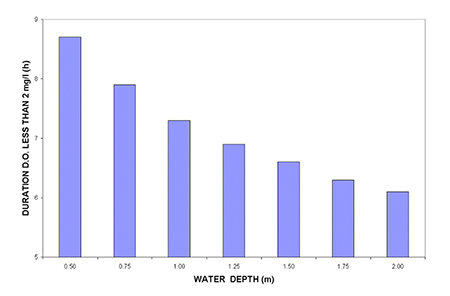
Dissolved-oxygen concentrations decline faster in older, shallow ponds for two reasons. First, the sediment has a proportionally greater effect on overall pond respiration rate in shallow ponds than in deeper ponds. Second, at the same concentration, shallow ponds hold a lower total mass of dissolved oxygen than deeper ponds.
Assuming a constant temperature and that dissolved-oxygen concentration declines as a result of respiration by plankton, fish, and sediment, oxygen is depleted faster in shallow ponds (Fig. 3). Starting with a dissolved-oxygen level of 10 milligrams per liter at dusk, followed by a 12-hour dark period, decreasing pond depth increases the time when the dissolved-oxygen concentration is less than the critical threshold for good fish production of 2 milligrams per liter (Fig. 4).
Maintaining water depth deeper than 1.50 to 1.75 m does not greatly reduce the duration of low dissolved-oxygen levels, because the effect of the sediment on overall respiration becomes progressively more “diluted” as pond depth increases.
Reducing sediment accumulation
Stabilizing pond banks to reduce erosion can reduce the rate of sediment accumulation. The benefits of a good grass cover have already been mentioned, but further efforts, such as stabilizing the bank with liners or other materials, are often prohibitively expensive.
At present, the only approach to dealing with sediment accumulation is to manage ponds to accommodate the problem. For example, ponds constructed of 1.5 m or less average depth should be drained and renovated every three to four years, so the sediment can be dried and compacted, or incorporated into levees before it becomes a problem.
Wider levees
Many farmers have recently constructed ponds with wider levees to allow for more erosion before it becomes necessary to renovate the pond. However, results of our study indicated that building wider levees alone is insufficient to extend the duration of continuous production.
The same management problems that limit seining and affect dissolved-oxygen dynamics will emerge, thereby defeating the intent of building wider levees in the first place. Wider levees must be accompanied by greater pond depth to extend the duration of fish production.
Conclusion
Erosion of pond levess leads to increasing sediment depth, decreasing water depth, difficulties in seining, and faster oxygen declines. Average pond depths of at least 2 meters, including freeboard, are recommended to allow additional depth for sediment accumulation. Extra freeboard is also desirable, because it provides extra water-storage capacity in ponds. The rainfall that is captured rather than allowed to overflow reduces the need for pumped water and the volume of effluent discharged.
(Editor’s Note: This article was originally published in the June 2001 print edition of the Global Aquaculture Advocate.)
Now that you've reached the end of the article ...
… please consider supporting GSA’s mission to advance responsible seafood practices through education, advocacy and third-party assurances. The Advocate aims to document the evolution of responsible seafood practices and share the expansive knowledge of our vast network of contributors.
By becoming a Global Seafood Alliance member, you’re ensuring that all of the pre-competitive work we do through member benefits, resources and events can continue. Individual membership costs just $50 a year.
Not a GSA member? Join us.
Authors
-
Jim Steeby, M.S.
National Warmwater Aquaculture Center
Mississippi State University – Extension Service
Belzoni, Mississippi, USA -
Sue Kingsbury, M.S.
National Warmwater Aquaculture Center
Mississippi Agriculture and Forestry Experiment Station
Stoneville, Mississippi, USA -
Craig Tucker, Ph.D.
National Warmwater Aquaculture Center
Mississippi Agriculture and Forestry Experiment Station
Stoneville, Mississippi, USA -
John Hargreaves, Ph.D.
National Warmwater Aquaculture Center
Department of Wildlife and Fisheries
Mississippi State, Mississippi, USA
Related Posts

Responsibility
Aquaculture ponds hold carbon
Although 16.6 million metric tons of carbon are annually buried in aquaculture ponds, estimated carbon emissions for culture species have approached several metric tons of carbon per metric ton of aquaculture product.
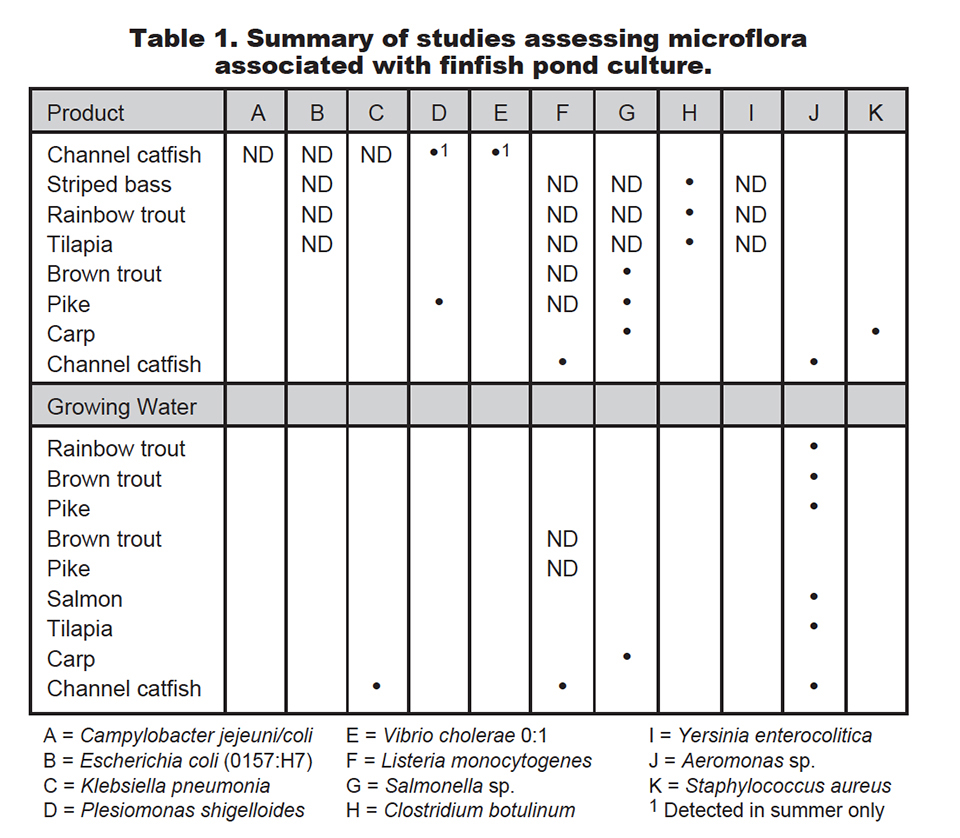
Health & Welfare
Microbial flora of aquaculture products
The microbial flora of farmed seafood products, particularly the microorganisms considered human pathogens, are important to individuals and agencies.
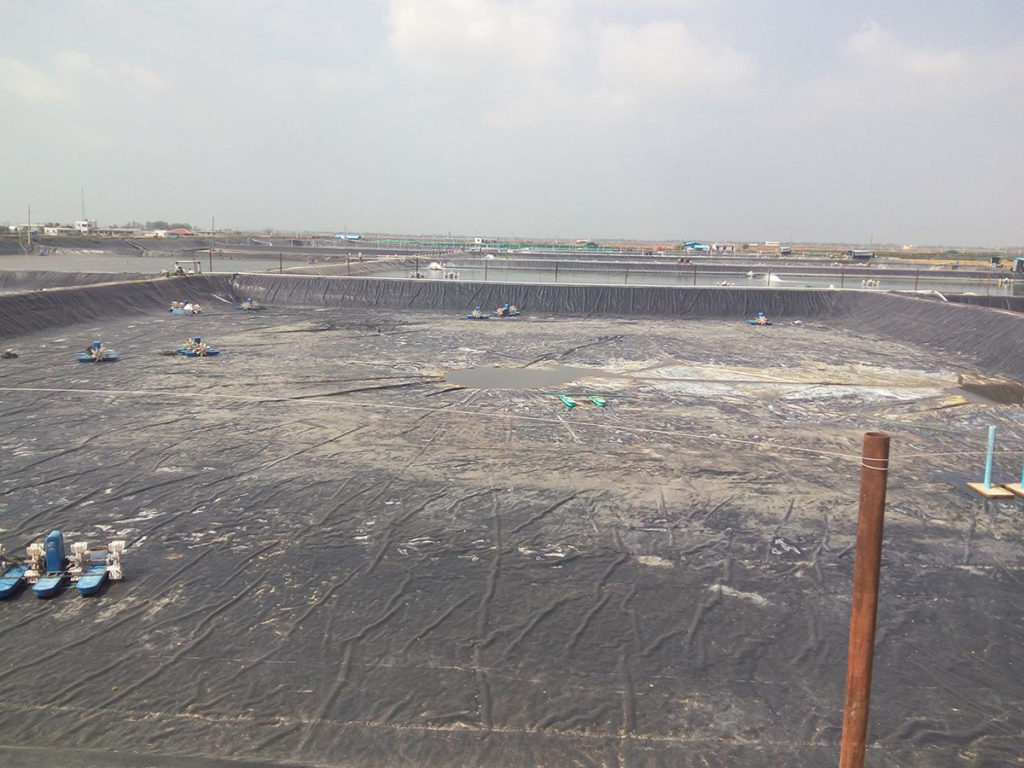
Responsibility
Appraising pond liners for shrimp culture
The use of plastic-lined ponds by shrimp farmers can significantly improve production efficiency, support more production cycles per year, and higher mechanical aeration rates and stocking densities. The capital cost of lining ponds can be very significant, so a thorough feasibility analysis is recommended when considering this production tool.
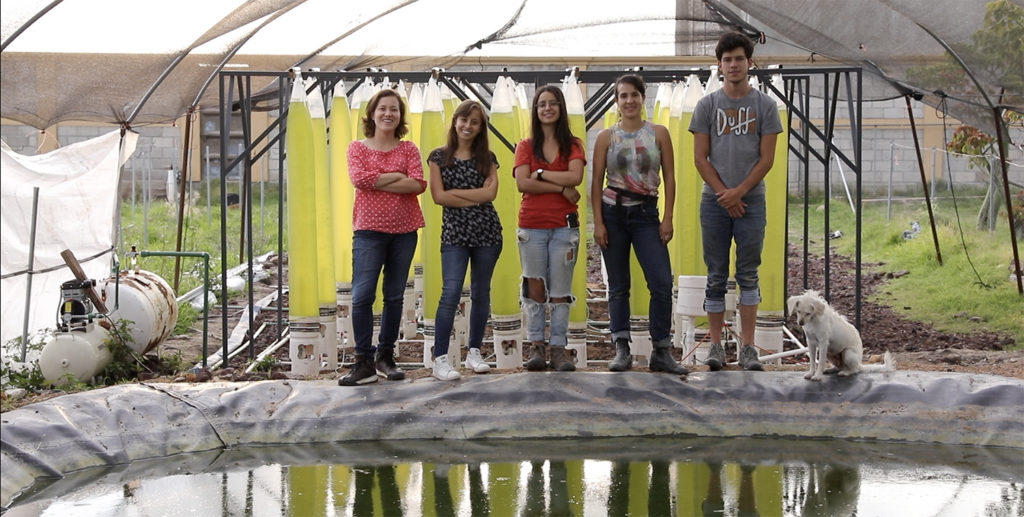
Aquafeeds
Mexican startup offers DIY aquafeed solution by upcycling wastewater
MicroTERRA is a promising Mexico-based startup developing systems that use microalgae to turn fishpond wastewater into protein for fish feed.


